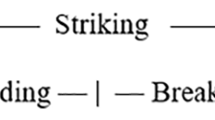Summary
Bergson and Whitehead have proposed a point of view where events rather than particles are fundamental entities. We follow this point of view as developed further by Capek and by Stapp by suggesting a framework in which fundamental events are taken to be point-like entities which interact with other fundamental events. Different kinds of fundamental events are to be distinguished by the rules of interaction. Examples of simple rules of interaction are given which lead to propagating patterns of events that can be interpreted as particles. The particles exhibit a wave structure and possess invariants, quantum numbers and quarklike constituents. They can react with each other and decay to form other particles, including antiparticles. A relativistic space-time co-ordinate system appears to be a natural way of organizing the event pattern. We argue that this kind of framework can provide a basis for unifying the concepts of quantum mechanics, elementary-particle structure and relativity.
Riassunto
Bergson e Whitehead hanno proposto un’interpretazione secondo cui gli eventi piuttosto che particelle sono entità fondamentali. Noi seguiamo questa interpretazione, sviluppata ulteriormente da Capek e Stapp suggerendo un sistema in cui gli eventi fondamentali sono considerati entità puntiformi che interagiscono con altri eventi fondamentali. I differenti tipi di eventi fondamentali si devono distinguere con le regole d’interazione. Si forniscono esempi di semplici regole d’interazione che portano a propagare modelli di eventi che si possono interpretare come particelle. Le particelle presentano una struttura d’onda e possiedono invarianti, numeri quantici e costituenti di tipo quark. Possono interagire l’uno con l’altro e decadere per formare altre particelle, comprese le antiparticelle. Un sistema di coordinate relativistiche spazio-tempo sembra un modo naturale di organizzare il modello degli eventi. Si deduce che questo tipo di sistema può fornire una base per unificare i concetti di meccanica quantistica la struttura delle particelle elementari e la relatività.
Similar content being viewed by others
References
H. Bergson:Creative Evolution, translated byA. Mitchell (Greenwood Press, Westport, Conn., 1975).
A. N. Whitehead:Process and Reality (corrected edition), edited byD. R. Griffin andD. W. Sherburne (The Free Press, New York, N. Y., 1978).
J. Jeans:The New Background of Science (Macmillan, New York, N. Y., 1933), p. 294.
M. Capek:The Philosphical Impact of Contemporary Physics (D. Van Nostrand, Princeton, N. J., 1961).
M. Capek:Particles or events?, inPhysical Sciences and History of Physics, edited byR. S. Cohen andM. W. Wartofsky (Reidel, Boston, Mass., 1984), p. 1.
H. P. Stapp:Phys. Rev. D,3, 1303 (1971).
H. P. Stapp:Nuovo Cimento B,29, 270 (1975).
H. P. Stapp:Found. Phys.,7, 313 (1977).
H. P. Stapp:Found. Phys.,9, 1 (1979).
N. Bohr:Atomic Theory and the Description of Nature (Cambridge University Press, Cambridge, 1934).
G. F. Chew:The topological bootstrap, inAsymptotic Realms of Physics, Essays in honor of Francis E. Low, edited byA. H. Guth, K. Huang andR. L. Jaffe (The MIT Press, Cambridge, Mass., 1983), p. 49.
G. F. Chew:Sci. Prog. (London),51, 529 (1963).
S. Gasiorowicz andJ. L. Rosner:Am. J. Phys.,49, 954 (1981).
E. C. Zeeman:J. Math. Phys. (N. Y.),5, 490 (1964).
A. R. Lee andT. M. Kalotas:Am. J. Phys.,43, 434 (1975).
J.-M. Levy-Leblond:Am. J. Phys.,44, 271 (1976).
N. D. Mermin:Am. J. Phys.,52, 119 (1984).
H. Weyl:Nachr. Akad. Wiss. Goettingen, Math.-Phys. Kl.,2, 99 (1921);T. Y. Thomas:The Differential Invariants of Generalized Spaces (Cambridge University Press, New York, N. Y., 1934), p. 21.
A. N. Whitehead:The Concept of Nature (Cambridge University Press, Cambridge, 1955), p. 66.
N. N. Bogoliubov andD. V. Shirkov:Introduction to the Theory of Quantized Fields (Interscience Publishers, New York, N. Y., 1959), p. 204.
Author information
Authors and Affiliations
Rights and permissions
About this article
Cite this article
Whipple, E.C. Events as fundamental entities in physics. Nuov Cim A 92, 309–327 (1986). https://doi.org/10.1007/BF02724247
Received:
Published:
Issue Date:
DOI: https://doi.org/10.1007/BF02724247



